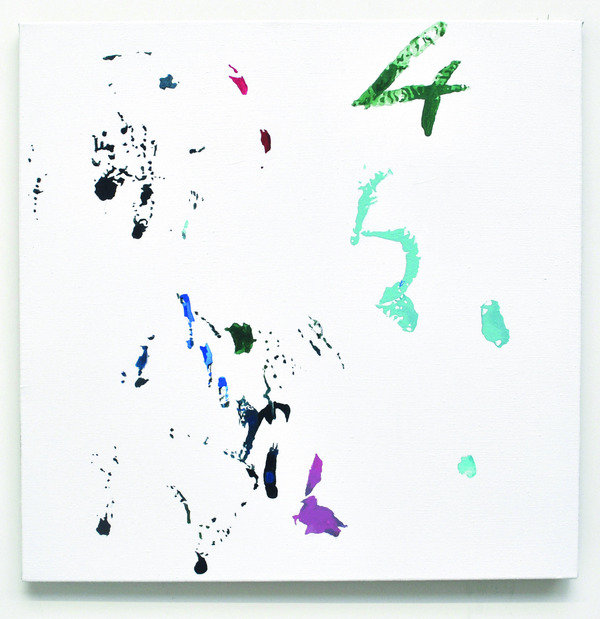Melissa Gordon
dal 1/2/2014 al 15/3/2014
Segnalato da
1/2/2014
Melissa Gordon
Deweer Gallery, Otegem
Modern surfaces exhibit two series that offer some pictorial and productive frames for thinking through seeing. During the exhibition the "Boomerang" video will be screened in the contiguous Blackbox.

(Excerpt from the essay “Structural and Expressive” by Marina Vishmidt)
How can a relationship to modernism be actual today? In an era when attempts to establish that relationship occur ever more frequently in exhibitions and discourse, it’s not an outlandish question. First, there has to be a structure for viewing: an instrument for measuring both the distance between one period and another, and the interferences that arise in taking up different positions with respect to this structure.
Both of the series exhibited in Modern Surfaces offer some pictorial and productive frames for thinking through seeing and history, representation and re-presentation—the whole array an anatomy theater of modernism’s afterlives. Core to these demonstrations is the movement, both light and rather schematic, from index to icon: the enlarged reproductions of sections of modernist paintings (icon) register both the painting and the cracks in the surface of the painting (index). Gordon prints the cropped section (new index) and this image, showing the artefacts of both printing processes, takes its place on the wall as a new icon (the Blow Up Modernists series).
Here, the sacralities of the modernist canon, whether in the key of the absolute (Mondrian, Malevich, Van Doesburg) or the existential (Pollock), are both reduced and enlarged: they are reduced in visual information, in color and texture, their aura sequestered, reduced to documentation, to information in general, to the printed medium—to the industrial civilization they were hoping to refract or transcend. At the same time, they are enlarged and multiplied, engendering a plethora of possible croppings that can become new works, like little clones off the production line of a cell. Of course, it was always the fate of absolute painting to be reproduced in the wilderness of commodity forms. Through their conversion to a printed material, here the terminal icons of Malevich are made to evoke transience and disposability. The dot-matrix look of a newspaper or comic book inevitably summons Pop Art’s mixing of media—specifically Lichtenstein—colliding the temporal logic of art history, the disparities in affect, and the unevenness of the object-relations involved.
In the painting series Material Evidence paint splotches on studio surfaces inject the old punchline of the abject un-meaning of the abstract expressionist canvas with a homely, gendered wit. It is the performance of an interior, but not a performance of interiority. A blunter play with the index-to-icon transit can be observed here: the mark of paint (index) is turned into a painting (icon), compressing in that transfer a whole history of canvas as index of gesture which becomes the icon of artistic genius. But, asks this image, what about the contingencies of housekeeping in the studio? Is a paint drip on some kinds of studio surface—canvas—any more expressive than dripping on others (wall, table)? What is this material evidence of? We could say it is nothing more than process, but that creates a tautology that eclipses the impact of the move, or, what makes it funny. Gordon calls the pieces “intentionally ridiculous,” their mixing-up of horizontals and verticals jinxing the immanence of the picture plane to its historically-certified content. If the expressive splotch was part of an expressive causality (it embodied the spirit of its time—the irreducible subject that was its maker), the Material Evidence series articulates a structural causality: it is produced by the woman artist, in her studio, dutifully, as an artwork – as proof of her right to be there. Detached from its generic premise of authenticity, like a bad translation in a service script, it labors to bring us nothing but joy.
During the exhibition ‘Modern Surfaces’ Richard Serra’s video ‘Boomerang’ (1974, Courtesy MoMA – Museum of Modern Art, New York), featuring Nancy Holt describing the effects of hearing the echo of her own voice in a recording studio, will be screened in the contiguous Blackbox.
Short biography
Melissa Gordon is an American-born and London-based painter, printmaker and editor. Recent exhibitions include Material Evidence (Spike Island, Bristol 2013), HERstories (Bonner Kunstverein 2013), Art & Press (Martin Gropius Bau, Berlin & ZKM, Frankfurt, 2012-13). She has also exhibited at S1 Artspace, Sheffield, Kunstmuseum Bonn, Marres Centre for Contemporary Culture, Maastricht, and Kunsthalle Dusseldorf. She recently curated the exhibition Specific Collisions at Marianne Boesky Gallery (2013) and is currently releasing the catalogue Material Evidence, published by Sternberg Press (2014).
Opening February 2nd 2014 at 15 - 18
Deweer Gallery
Tiegemstraat 6 a, Otegem
Open hours: Wednesday-Friday & Sunday 14-18h & by appointment
Free entrance



